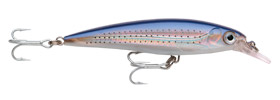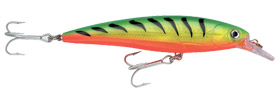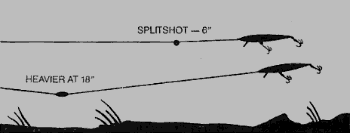Rapala Lures - the best lures in the world!
More world record fish have been caught with Rapala lures than any other in the world. Any other!
And, Rapala holds the world record for world records.
And, Rapala holds the world record for world records.
On this page:
The Hunt for the Most Realistic Lure
Rapala: The Most Realistic
What is a Rapala Lure?
The 1st Rapala Lure
Rapala Tips and Tricks
The Rapala Knot
The Hunt for the Most Realistic Lure
When we use fishing lures as bait, it's extremely important that we're using the most realistic fishing lure that we can. When it comes to fishing lures, the choices are almost endless. They come in seemingly every shape, color, and size, and yet finding one that truly looks realistic is difficult. Some are more realistic than others of course, but some are truly remarkable in their realistic appearance.In our experience some fishing lures look realistic, some don't. They all tend to look quite realistic out of the water, but what's important is how they look under the water. This is where cheap imitation fishing lures aren't worth the couple of dollars that they cost you. For this reason, it's important to stick with quality manufacturers or actually see what a fishing lure will look like under water, before you spend any of your hard earned money on it..
Rapala: The Most Realistic

The most famous manufacturer (that makes very realistic fishing lures) is Rapala. Rapala makes fishing lures that are very realistic, and any money that you spend on Rapala lures will not be wasted.
Rapala are currently the world's largest manufacturer of fishing lures and other fishing related products, selling around 20 million lures every single year. They are sold in 140 different countries around the world, and have aided in catching more world record fish than any other brand of lure. With a reputation spanning over 70 years, they are well respected within the market and are a firm favorite with all serious fishermen.
What also stands them apart from any other similar companies is that unlike some other brands that have reverted to producing their lures in plastic; Rapala has maintained their tradition, producing their lures from balsa wood. It is this extreme popularity which has allowed the company to flourish and expand their product range which now includes fillet knives, scales and reels, as well as their world renowned lures.
They have remained the world's favorite lure since the 1930's and don't seem to be losing this title anytime soon. With a Rapala lure, you are not only purchasing a quality piece of fishing equipment which is successful and reliable in hooking in your catch, you are also purchasing part of a fishing legacy.
What is a Rapala Lure?

They are actually called a balsa lure. Rapala (the brand) were the first to invent the balsa lure and that's why Rapala is commonly used to describe the Balsa Lure. Balsa or Rapala lures were first made from balsa wood. Generally Rapala lures range anywhere from 5cm - 25cm in length.
Some rapalas feature built-in rattles. The rattles are used to attract and simulate injured fish or even the sound of work ups.
In New Zealand and the Pacific Islands the large Rapala's are the most popular and are mostly used for targeting Kingfish, Tuna, Giant Trevally and other large species. Kingfish find them irrestible! We've found that they are particularly good to troll through works or around reef structures.
Rapala lures have a front lip performs two tasks. Firstly it keeps the lure in an upright position when its being trolled or casted, and secondly it also causes the lure to flutter and vibrate imitating a baitfish trying to swim away from or escape a larger preditor fish species. Generally the larger the lip the more active the lure swims. Traditional lips dive down from 1-5 meters.
Some feature a special Deep Diving Lip which swims the lure down into depths of 6-10m below the surface. This is a good option when trolling in depths of 20m+ putting the lure right in the strike zone.
We think Rapala Lures are a must have in the tackle box...
Check out some amazing everyday deals on Rapala Lures....
The 1st Rapala Lure
It all began with a hungry Finnish guy and a carving knife. It was the 1930s when a simple fisherman made an observation of simple genius: Big fish eat little fish, especially little fish that are wounded. He saw how hungry predator fish would dart into a school of minnows and attack the one that swam with a slightly off-center wobble. Over and over again.Lauri Rapala realized that if he could craft a lure that mimicked the movements of a wounded minnow, he could catch more fish. Using a shoemaker’s knife and some sandpaper, he created his first successful lure from cork in 1936. Tinfoil from chocolate bars formed the lure’s outer surface. Melted photographic negatives the protective coating. But most importantly, it perfectly imitated the action of a wounded minnow. Legend has it that Lauri sometimes caught 600 pounds of fish a day with that new lure. The rest, as they say, is history.
Rapala Tips and Tricks
- 1. The first tip is to use the lightest terminal tackle possible.
- 2. The second cardinal rule involves the use of sinkers for applications where extra depth is necessary. Keep the sinkers as far from the lure as practical to reduce interference with the built-in action.
- 3. The third cardinal rule pertains to the action of the lure: Before you use your Rapala for the first time, we recommend that you check its action, from the boat or a dock, so you can visually confirm the best speed and rigging to give it the most life-like swimming action.
- 4. When trolling, slowly play out the Rapala from the boat, keeping visual contact with the lure for as long as you can to make sure that it is trailing properly with the correct action.
- 5. Tie your line directly to eye of the lure if you can with a Rapala Knot for most applications.

The Rapala Knot

1. Tie an overhand knot. Leave 5" of free end. Run free end through the eyelet.

2. Run free end back through overhand knot.

3. Wrap free end around standing part of line 3 times.

4. Thread free end through back of overhand knot.

5. Pass free end through loop that is formed.

6. Moisten line and draw up tight. Trim excess.
|
|












